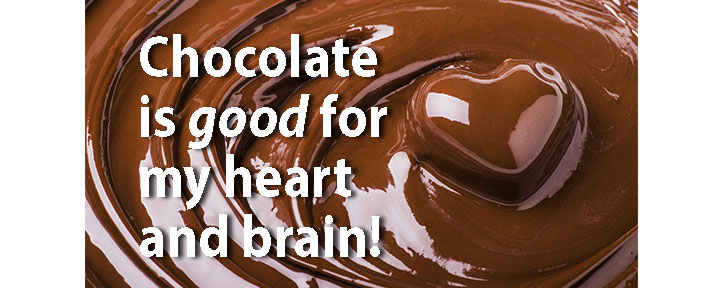
When everything I LOVE to eat is terrible for my waistline and health, I am savoring a new study that says that CHOCOLATE helps keep the heart’s blood vessels healthy. Yup! According to Baylor College of Medicine,
“Chocolate contains heart healthy nutrients such as flavonoids, methylxanthines, polyphenols and stearic acid, which may reduce inflammation and increase good cholesterol.” The study found that eating chocolate more than once a week can decrease coronary artery disease by 8%.
In other words, the antioxidants in chocolate help reduce inflammation, improve blord flow, and boost mood and concentration. It helps keep plaque from building up in the lining of blood vessels, and it reduces blood pressure and helps prevent stroke and heart failure. And if that isn’t enough good news, chocolate improves blood flow to the brain, which may improve cognitive function.
Dark chocolate has more benefits than white or milk chocolate, and it’s best to get chocolate that not highly processed. I like Lily’s Dark Chocolate Almond bars. They’re sweetened with stevia and they have 55% cocoa.
It’s nice to know that my favorite dessert is actually good for my heart and memory.

When everything I LOVE to eat is terrible for my waistline and health, I am savoring a new study that says that CHOCOLATE helps keep the heart’s blood vessels healthy. Yup! According to Baylor College of Medicine,
“Chocolate contains heart healthy nutrients such as flavonoids, methylxanthines, polyphenols and stearic acid, which may reduce inflammation and increase good cholesterol.” The study found that eating chocolate more than once a week can decrease coronary artery disease by 8%.
In other words, the antioxidants in chocolate help reduce inflammation, improve blord flow, and boost mood and concentration. It helps keep plaque from building up in the lining of blood vessels, and it reduces blood pressure and helps prevent stroke and heart failure. And if that isn’t enough good news, chocolate improves blood flow to the brain, which may improve cognitive function.
Dark chocolate has more benefits than white or milk chocolate, and it’s best to get chocolate that not highly processed. I like Lily’s Dark Chocolate Almond bars. They’re sweetened with stevia and they have 55% cocoa.
It’s nice to know that my favorite dessert is actually good for my heart and memory.
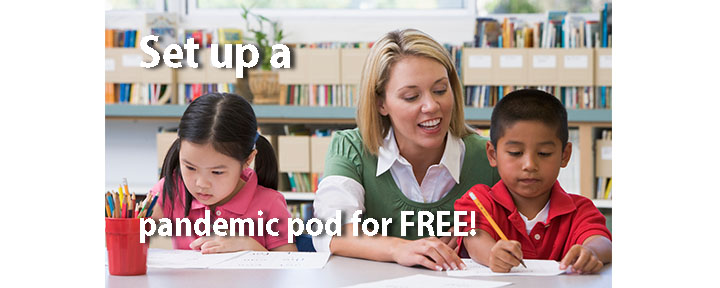
While K-12 schools are playing tug of war as they make decisions about online or on campus classes this fall, “pandemic pods” or “learning hubs” are popping up in the Bay Area. These pandemic pods or learning hubs are in-person groups where a small number of students work with a teacher in small group settings.
Wealthy families band together to hire a teacher to work with their children to ensure that they get the academic instruction they need so they don’t lose momentum and they’ll be ready to move on next year. I’m setting up these pandemic pods for families as they prepare for the new school year. They pool their dollars to create classes for their children – usually reading, math and science. Wealthy families typically have the funds to make sure their children don’t slip through the cracks.
Low-income families, however, don’t usually have that luxury, which causes a socio-economic rift that continues to widen the gap between the haves and the have nots. But in San Francisco, the SF Dept of Children, Youth and their Families has created learning hubs for 6,000 low-income students. They have targeted students who don’t have computers, internet, or stay-at-home parents – the students who were left out of online zoom classes last spring. These 40 hubs are located walking distance from public housing, foster care, homeless youth, and others who need more support during the shelter-in-place and online classes. And all of these services are completely free to these students.
These learning hubs will operate out of the Parks and Rec Dept and other nonprofit organization sites. They’ll have computers and internet connections so they can participate in online classes, and they’ll also have teachers available to help them on site. These students will also have access to meals and snacks, exercise, and other students. The hubs will serve kindergarten through 6th grade students and they’ll be open Monday through Friday during school hours.
For families that aren’t wealthy or don’t have access to learning hubs, they can also create their pandemic pods and set up classes in their homes for FREE. The hosting families organize the pods by hiring their teachers, purchasing materials, and recruiting 2-4 students. The tuition that the other students pay will cover the teacher’s wages and materials. With a little planning and ingenuity, the hosting family benefits from these classes and they don’t need to be wealthy to do it. I’ve written a book that lays out all the steps to set this up. So the pandemic pods don’t have to be separate but unequal.
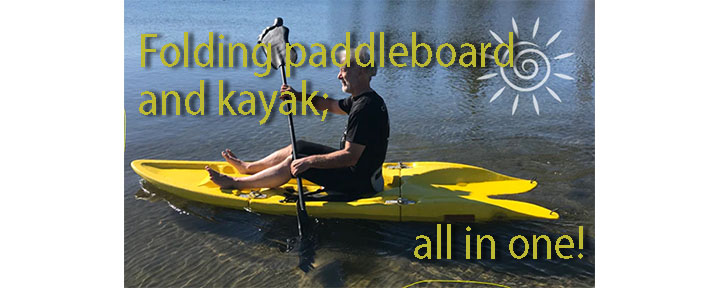
My friend Tim Niemier, creator of the Ocean Kayak, has just launched his Origami Paddler on Kickstarter. This paddleboard is a brilliant design – folds in thirds for easy storage and transportation! The paddle actually fits inside the folded paddleboard too!
I have 2 of his Origami Paddlers and took them to Shasta on a houseboating family vacation a few years ago. Everyone loved it! Tim is making these paddleboards using 100% recycled plastic – so I am helping divert plastic waste from the landfill while getting some exercise!
This Origami Paddler is also a kayak! It’s just like his sit-on-top kayaks that he invented and designed back in the ‘70s. I have his Malibu Two kayaks, but rarely take them out because they’re huge and heavy. Now this Origami Paddler is both a kayak and paddleboard — and they fold so they fit in my trunk. Wow!
It retails for over $500, but on Kickstarter you can get it for as little as $279.
I’m getting 2 more so my whole family can go out together! It’s a great way to get exercise, be with others (more than 6 feet apart), and get some sun! Tim started his Kickstarter campaign to raise $25,000 28 days ago, and today, he’s raised over $400,000! Looks like his Origami Paddler will be as successful as his Ocean Kayaks!
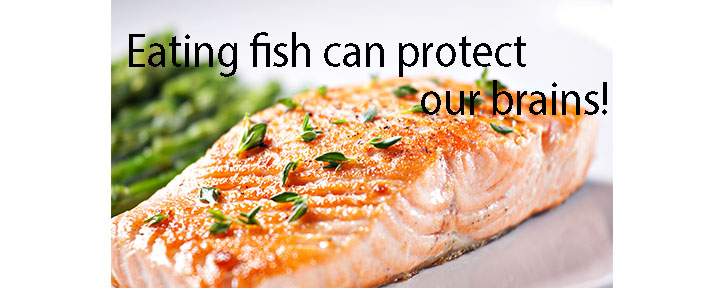
Just read a study about how eating fish (or taking omega-3 or fish oil supplements) could protect our brains from cognitive decline caused by air pollution. This seemed odd to me because I just purchased a really great air filter with a hepa-filter to protect me from air pollution.
But according to Neurology, the medical journal of American Academy of Neurology,
“Omega-3 fatty acids have been shown to fight inflammation and maintain brain structure in aging brains. They have also been found to reduce brain damage caused by neurotoxins like lead and mercury.”
Fatty fish that is baked or broiled (wild salmon, mackerel, and tuna) are the best sources for omega-3s. They say that fried fish loses the benefits because of the deep frying process. So no fish and chips!
Environmental neurotoxins are a problem for the brain because the particles are so small that they can be breathed into the lungs. From there, they can be distributed throughout the body via the bloodstream and cause neuroinflammation and cognitive decline.
Because omega-3s have anti-inflammatory properties, they can protect the brain. So have seafood once or twice a week to possibly stave off dementia. Well, that is some news I can embrace – I love wild salmon!
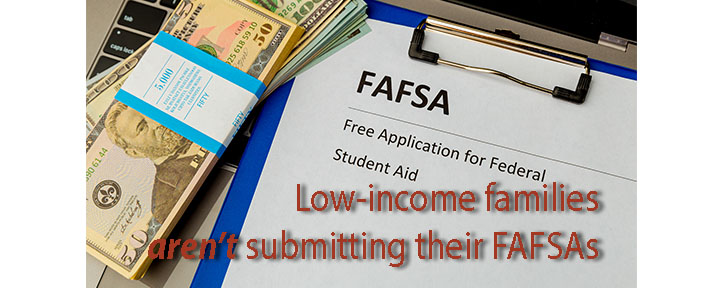
Low-income students (families) are making fewer deposits for college this fall than in previous years, and those who are making deposits are NOT submitting the FAFSA (Free Application for Federal Student Aid). Of course, this makes sense considering parents may be unemployed or under-employed as a result of the coronavirus and shelter-in-place (SIP) orders. Many parents are overwhelmed and probably don’t realize that they need to complete the FAFSA for scholarships and financial aid.
When parents and students don’t complete the FAFSA, their colleges don’t know how much their families can pay for college tuition, room and board. Colleges generally won’t give scholarships or financial aid offers without the FAFSA.
Black and Latinx families make up a huge percentage of students and families who haven’t filled out the FAFSA and who may not attend college this year. Parents can start filling out the FAFSA in October and the actual opening date is January 1st. The official deadline is in March, but parents can fill out the form as late as June 30th.
We need to tell low- and middle-income families to complete the FAFSA to learn about scholarships and financial aid their children may receive. It’s vital that we make a college education available to all students of any ethnicity and any socio-economic status.
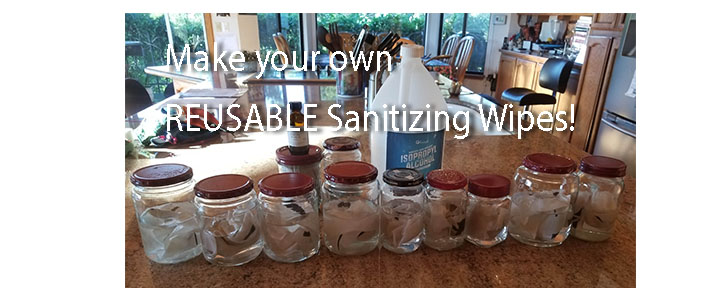 Flustered that I couldn’t buy sanitizing wipes back in March because people were hoarding them, I cut the wipes in half to make them last longer. That’s when I decided to make REUSABLE wipes. Let’s keep them out of the landfills – and we won’t run out when the next wave hits!
Flustered that I couldn’t buy sanitizing wipes back in March because people were hoarding them, I cut the wipes in half to make them last longer. That’s when I decided to make REUSABLE wipes. Let’s keep them out of the landfills – and we won’t run out when the next wave hits!
Making my reusable sanitizing wipes was easy. I gathered glass jars and 3 simple ingredients:
1 cup Rubbing Alcohol
1 Tbsp Aloe Vera Gel
3 drops Essential Oil
Then I cut up some old pillowcases (8” x 8”). I filled the jar with about ½ cup of the sanitizing solution. For fun, I made labels, and then made 20 reusable sanitizing wipe containers. Now I have one in every room in my house, garage, and greenhouse – I even put one out on my new deck!
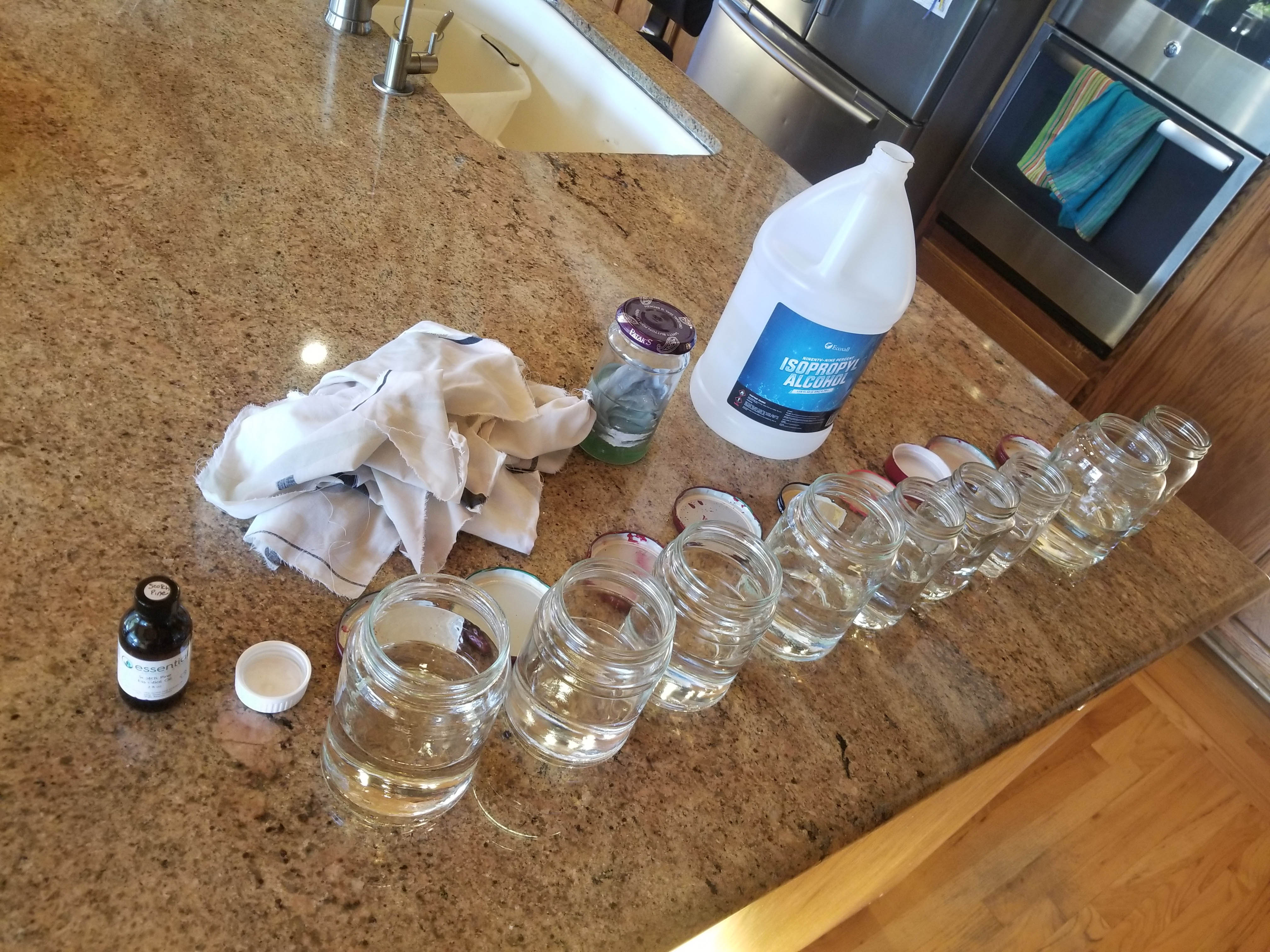
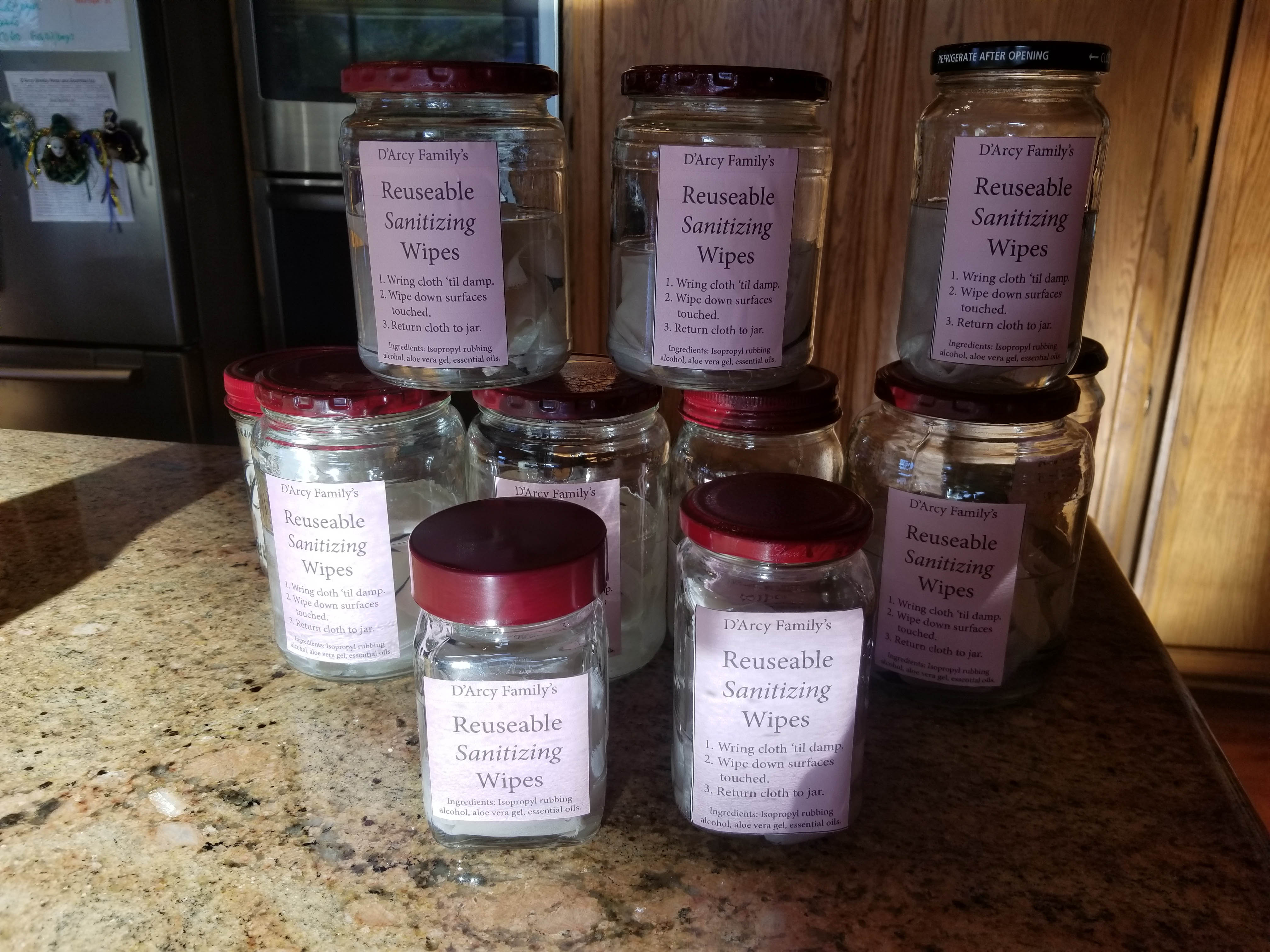
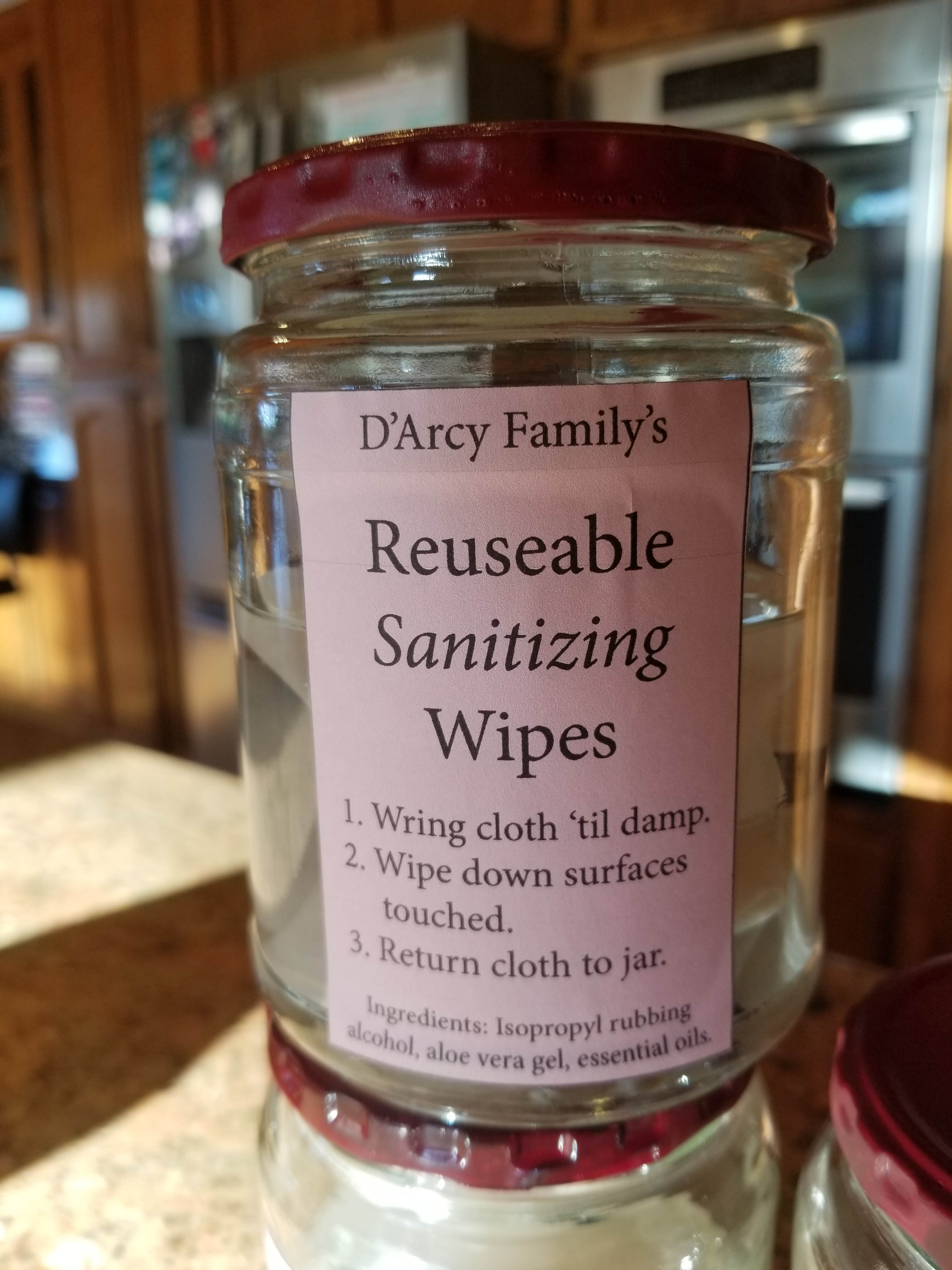
Oops! Just realized that I spelled “reusable” wrong!
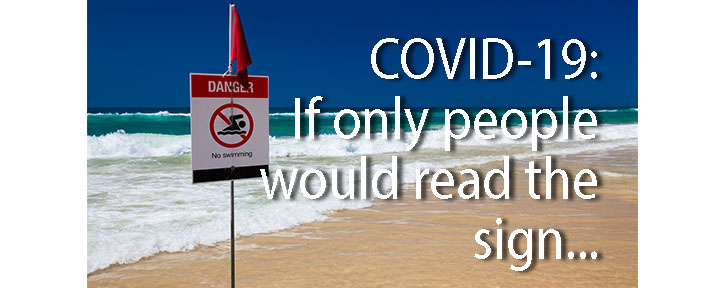
I’ve been confused by the recent “spikes” in COVID-19 cases around the world — wondering if they were an early “wave” that we were expecting this fall. Check out this analogy that helps make sense of the spread:
Why did the second wave of COVID-19 start so soon? Everyone said it wouldn’t happen until the fall. Does that mean the fall one will be a third wave? How many waves will there be? Who can we trust now?
This whole “wave” thing is dreadfully misunderstood. For the moment, forget about “waves” and think, instead, in terms of swimming in shark-infested waters.
You are at the beach, with hundreds or thousands of others, enjoying the water, body-surfing, and having a good time.
All of a sudden, the lifeguards spot sharks, and several swimmers are killed. Body parts bob in the ocean and wash up on shore.
The coast guard observes entire schools of sharks, and swimmers are warned NOT to go into the ocean. But, a few people ignore the warning and take their chances by swimming in the ocean. Several more people are mutilated by these sharks, and then more sharks appear because the water is now rich with food (blood and body parts).
Finally, the beach is closed and nobody is allowed in the water. Then, shark attacks go down because nobody is swimming in the water. People are staying on home or staying far away from the shoreline.
But, the sharks are still there. Nobody did anything to eliminate or get rid of the sharks, right?
With no casualties for days, or even weeks, swimmers go to the beach to enjoy the water, bodysurf, and have a good time. Note: “Beach Closed” signs were still posted but the swimmers decided to go ahead and enter the water.
Guess what happens?
The sharks maime and kill them! Lots of them.
Why? Because people went back into the water before it was safe to do so.
Now think COVID-19. We haven’t found a way to stop the coronavirus. We have no vaccine. We have no cure. The virus is still out there and still killing people. If you go out and expose yourself to the coronavirus, you are increasing the chance of getting sick or dying.
The only “wave” is the wave of PEOPLE who disregard warnings to stay home, keep a safe distance from others, and wear a mask because they think the coronavirus is under control. And every time they go out, more people get sick, spread the virus to others, and die.
The virus doesn’t “do” waves; PEOPLE DO.
Think Florida, Texas, and California. These states are seeing surges in numbers of COVID-19 because PEOPLE are disregarding the warnings from scientists and doctors.
Until we know how to kill the coronavirus or have an effective vaccine, our only defense is to stay home, keep a safe distance, and wear a mask — until the virus has no more human food.
I paraphrased John Geare’s brilliant analogy.
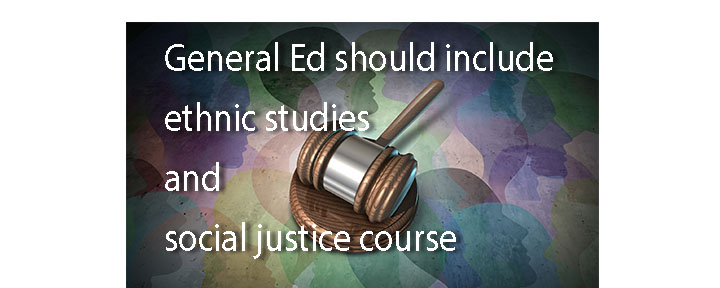
Amidst the escalation of the Black Lives Matter BLM movement, resurgence of humanitarian refugee and immigration decisions, and the rise in white supremacy groups, the California State University system (23 colleges) just approved an ethnic studies and social justice course to be included in their general education requirement for a bachelor’s degree. It’s about time schools include discussions about race, discrimination, and equity.
I believe that these discussions should start in kindergarten and continue as part of the curriculum framework through 12th grade. Children are not born with hatred about people who are different from themselves; they are taught these awful biases from family, friends, neighbors and community. By learning about various ethnicities and religions at an early age, I hope children will grow up appreciating cultural differences. In middle and high school, students should learn about the history of discrimination in the US and the world. They can be encouraged to support people who are shunned, and they can start projects to stop injustices from happening.
I applaud the CSU system for recognizing the need to educate students about social justice issues that have spiked and run amuck. I do hope that these courses will be incorporated in the K-12 curriculum to start these important discussions while children are formulating their life-long opinions.
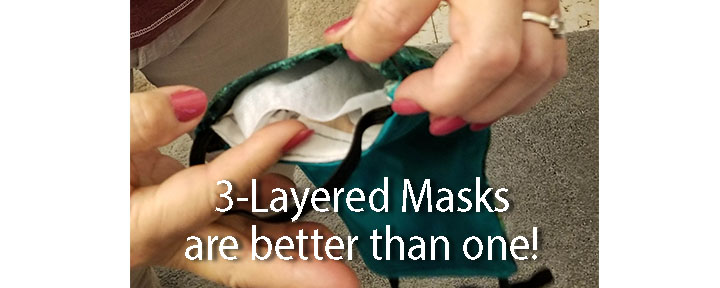
If you’re going to wear a cloth mask, Australian researchers say that masks with two or three layers better protect against the spread of the coronavirus than single-layered masks. Phew! Michele Roush and I sewed hundreds of masks for ER healthcare workers and firefighters. Our three-layered masks have a pocket for a filter to add even more protection.
Here is the pattern we used.
Here is a video I made to show you how to sew them.
I posted this blog: Make masks for healthcare workers back on April 3, 2020. They actually need N95 masks while working with COVID-19 patients; these three-layered cloth masks are for the public. Mask up to stop the spread of the coronavirus!
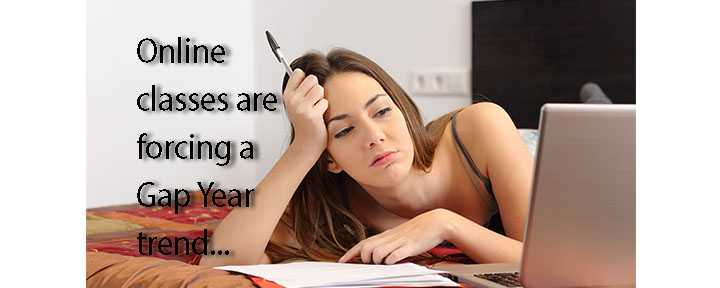
As COVID-19 ramps up this summer, colleges are struggling to justify opening up their campuses to students this fall. They need to offer on-campus courses and bring students back to the dorms in order to justify charging full tuition, room and board, yet they don’t want faculty and students to succumb to the coronavirus on their watch. This indecision about opening up campuses and the unknown about the second wave of the coronavirus this fall is now causing a new trend of students taking a gap year.
Normally, just a few students take a gap year between high school and college. These students either aren’t quite ready to make the big jump into a 4-year program or they have sports or projects that need to be completed before transitioning to college. Others take this opportunity to travel abroad or immerse themselves in research or work. They know college will be there for them when they’re ready.
But this year, students are choosing to take a gap year because they don’t want to miss their “college experience.” Living at home in their old bedrooms under family rules – and now “shelter-in-place” rules – stuck behind their laptops is not quite how they want to spend the next school year. They only get 4 years of living the college dream and they don’t want to waste one (or more) of those years living and studying from home. Parents are also on board for gap years because forking out $30,000 to $70,000 just doesn’t make sense when their kids are living and eating at home and taking classes online.
Taking a gap year while sheltering in place will be a completely different experience for these students. Most will not be able to travel abroad, do internships, or get jobs. The big difference this year is that many students are opting to take gap years because they want to live on campus, whereas previously, students took gap years to do something special.
Not all colleges allow gap years so check with your college to lay out a plan. Some colleges require that you reapply the following year. Others don’t allow students to take classes at other institutions during the gap year.
If taking a gap year makes financial sense, make good use of this year. Volunteer and support programs that help people struggling while sheltering in place. Work with your political party to get out the vote. Learn a foreign language. Build technical computer skills. Read, read, read! Consider your options and lay out a plan to ensure that you’ll be happy and satisfied with your decision to take a gap year.
